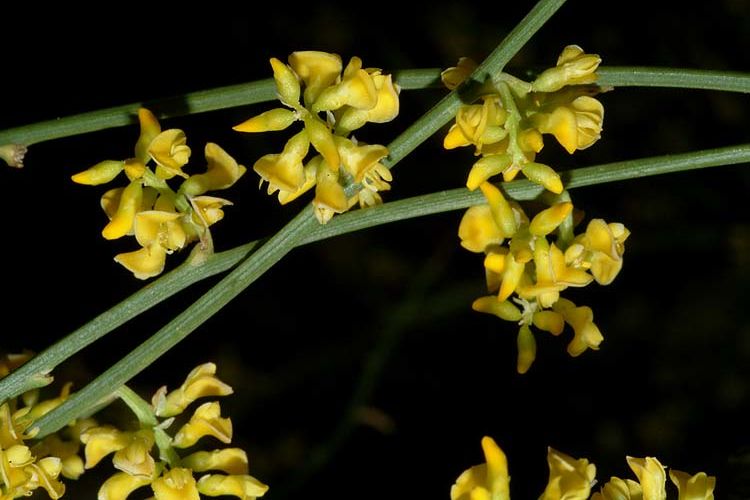Spanish Broom
retama sphaerocarpa
Also known as: ["False Broom","Olivella Broom"]
Overview
A deciduous shrub native to the Mediterranean region, known for its bright yellow flowers and sparsely foliated stems.
Benefits & Perks
["drought tolerant","fragrant flowers","wildlife attractant (bees, butterflies, birds)"]
Botanical Classification
| Phylum: | Magnoliophyta |
| Class: | Magnoliopsida |
| Order: | Fabales |
| Family: | Fabaceae |
| Genus: | Retama |
| Botanical Name: | Retama sphaerocarpa |
Plant Characteristics
Basic Information
- Category: Shrubs
- Suitable Location: rock garden, xeriscaped area, or sunny border
- Suitable For:
- Is Weed: No
- Allergenicity: low
Environmental Needs
- Climate: {"temperatureRange":"–10–40°C"}
- Hardiness: {"zones":"6–9"}
- Misting: rarely required
- Drainage: Fast-draining to prevent root rot.
- Soil Type: Well-draining cactus or succulent mix with added perlite or sand.
Maintenance Level
- Maintenance Level: low
- Toughness Level: high
- Pruning Frequency: Annually or as needed to remove deadwood and maintain form.
- Pruning Intensity: Moderate; selective removal of older or damaged stems.
Care Details
Ideal Sunlight Coverage:
Full sun (6–8 hours of direct sunlight daily); adjust to partial shade in extreme summer heat.
Sunlight Tolerance Tips:
Acclimate gradually if moving from shade to sun; protect from intense midday sun in summer; ensure outdoor placement in full sun for best growth.
Care Requirements
Care Difficulty
moderatemoderate
Sunlight
full sun
Avoid sudden light changes; provide full sun exposure; monitor for sunburn.
Watering
every 4–6 weeks during active growth, less in winter
Water thoroughly until runoff, ensure excellent drainage, and avoid frequent light watering.
Soil
well-drained, sandy or gravelly soil
pH: Slightly acidic to neutral (pH 6.0–7.0).
Ensure pots have drainage holes; avoid heavy garden soil; topdress with gravel for extra drainage.
Temperature
Ideal range 60–85°F (15–29°C); tolerates mild frosts but prefers warm, dry conditions.
Protect from frost; avoid extreme heat; maintain consistent warmth.
Fertilizing
every 2 months during spring and summer, none in winter
Use a cactus-specific fertilizer; fertilize only when actively growing; flush soil occasionally to prevent salt buildup.
Propagation
Methods
Stem cuttings or seed.
Step-by-Step Propagation Guide
- Select healthy stem.
- Cut below a node.
- Let callus form.
- Plant in medium.
- Keep moist and warm.
Best Time: Spring or early summer when the plant is actively growing.
Environment
Warm (70–80°F), high humidity (60–70%), and bright indirect light.
Medium
Well-draining mix of perlite and cactus soil.
Hormone
Optional, but recommended for faster rooting.
Timeline
4–8 weeks for roots to develop; additional months for establishment.
Tools Needed
Pruning shears, rooting hormone, propagation tray, misting bottle.
Quick Tips
Use sterile tools; avoid overwatering; provide bottom heat for faster rooting.
Pruning & Repotting
Pruning Guide
Method
Cut back to a healthy bud or branch junction; avoid excessive pruning in winter.
Pruning Plan
Remove dead or overgrown branches to maintain shape and encourage airflow.
Tools
Pruning shears, loppers (for larger branches), sterilizing solution.
Checklist
Sterilize tools; prune deadwood; shape the plant; clean up debris.
Repotting Guide
Best Season
Spring, before the active growing season begins.
Pot Size
One size larger pot (e.g., +2 inches in diameter).
Method
Remove plant gently; trim roots if needed; place in a slightly larger pot with fresh cactus mix; ensure drainage.
Suggestions
Repot every 2–3 years or when roots fill the pot; necessary to refresh soil and provide space.
Checklist
Check root bound status; prepare new pot; use fresh soil; water lightly after repotting.
Advanced Care Tips
Watering Mastery
Watering Checklist
Check soil moisture; water deeply; ensure drainage; adjust for season.
How to Apply Water Properly
Water directly at the root zone, apply until water drains from the bottom, ensure the soil is moistened deeply, and water in the morning to reduce evaporation.
Watering Schedule Tips
Water deeply but infrequently, allowing soil to dry out between waterings. Reduce watering in winter to once every 4–6 weeks, depending on conditions.
Soil Improvement
Add coarse sand, perlite, or pumice to improve drainage; incorporate organic matter for fertility.
Temperature Stress Management
Signs of Temperature Issues
Chlorosis, leaf drop, stunted growth, or browning leaf tips.
Cold Stress
Slows growth, may cause leaf drop, and can lead to root damage in prolonged cold.
Solution: Move to a warmer location, provide frost protection, and reduce watering in cold periods.
Hot Stress
Wilting, leaf scorch, or reduced flowering due to excessive heat.
Solution: Provide partial shade during peak heat, increase humidity, and water deeply but infrequently.
Fertilizing Guide
Fertilizing Checklist
Check growing season; dilute fertilizer; apply to moist soil; avoid winter feeding.
Fertilizing Method
Use a balanced, low-nitrogen fertilizer diluted to half strength every 4–6 weeks during growing season (spring–summer); avoid fertilizing in winter.
Common Problems & Solutions
Toxicity Warning
Cats
Slightly ToxicCats may experience mild gastrointestinal symptoms if they ingest parts of Retama sphaerocarpa. The toxicity is not severe but can cause discomfort.
⚠️ Symptoms:
🌿 Toxic Parts:
⚡ Toxic If:
if eaten
Dogs
Slightly ToxicIn dogs, ingestion of Retama sphaerocarpa seeds and bark can lead to mild gastrointestinal upset. The toxicity is generally low, but symptoms may occur if consumed in significant amounts.
⚠️ Symptoms:
🌿 Toxic Parts:
⚡ Toxic If:
if eaten
Humans
Slightly ToxicRetama sphaerocarpa contains compounds that can cause mild gastrointestinal distress and other mild symptoms upon ingestion. The toxic effects are generally not severe but can be problematic in large quantities or in sensitive individuals.
⚠️ Symptoms:
🌿 Toxic Parts:
⚡ Toxic If:
if eaten
Frequently Asked Questions
Q: Is Retama sphaerocarpa toxic to pets?
A: Yes, it is toxic to dogs and cats.
Q: Does this plant require frequent watering?
A: No, it is drought-tolerant and requires minimal watering.
Q: Does Retama sphaerocarpa attract wildlife?
A: Yes, it attracts bees, butterflies, and birds with its fragrant flowers.
Quick Reference
| Family: | Fabaceae |
| Care: | moderate |
| Light: | full sun |
| Water: | every 4–6 weeks during activ |
Get Expert Care Tips
Download the Plantious app for personalized care reminders and plant identification!
Google Play App Store








